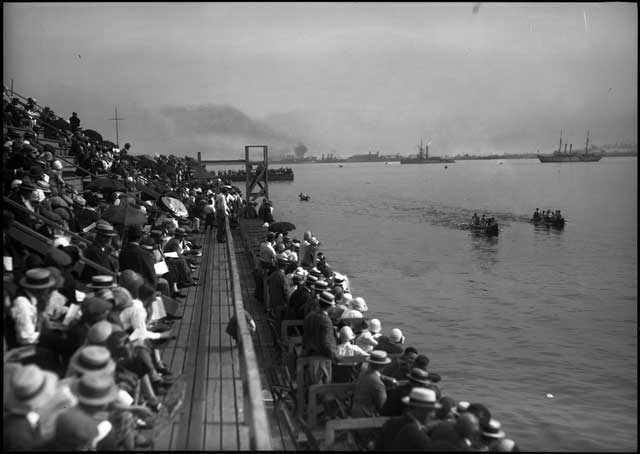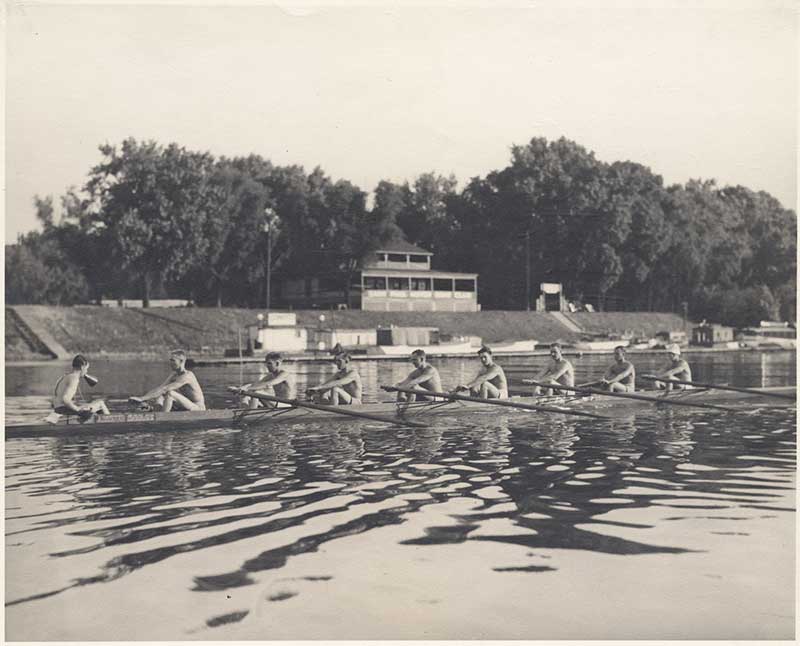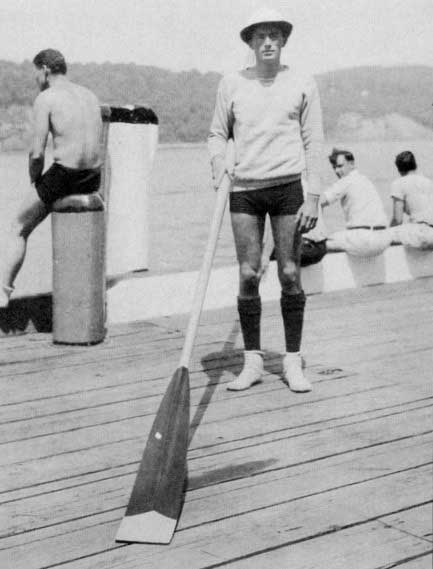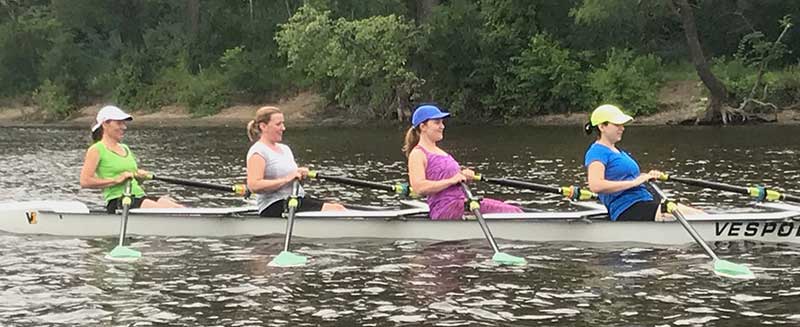Small Home Gazette, Summer 2018
Rowing in the Bungalow Era
“All were merged into one smoothly working machine; they were, in fact, a poem of motion, a symphony of swinging blades.”
—from The Boys in the Boat
When was the last time you heard about rowing? The 2016 Summer Olympics, when rowers had concerns about raw sewage in Rio? The debate over the Mississippi River dam disposition studies? A book review of Daniel James Brown’s The Boys in the Boat?
The Sport of Rowing
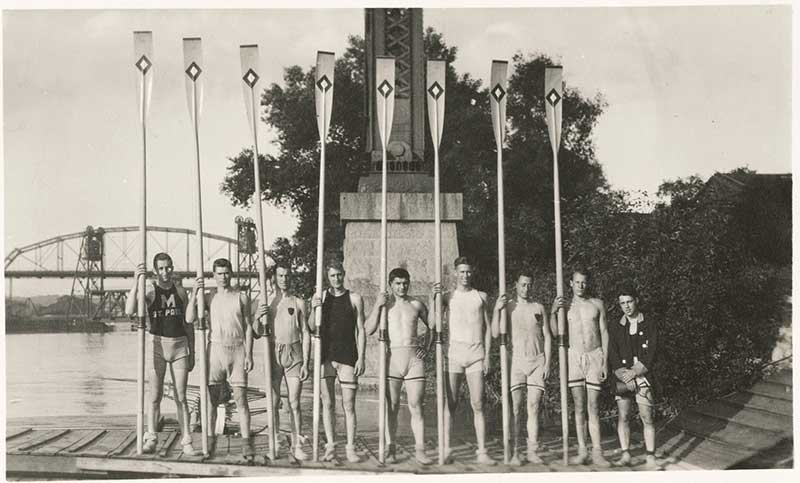
The junior “eight” of the Minnesota Boat Club in 1915. Used with permission of the Minnesota Historical Society.
When most people think of the sport of rowing, they picture an “eight”—a narrow boat approximately 60 feet long, powered by eight classically tall rowers, each with one oar, moving backwards through the water and steered by a coxswain, who weighs no more than 125 pounds. But there are other configurations. Crew boats can either be “sweep,” with two, four, or eight rowers using one oar each; or “scull,” with one, two or four rowers pulling two oars each.
Early Rowing
While various forms of rowing events and competitions have been held worldwide for centuries, organized amateur rowing only arrived in the United States in the 1830s. The sport quickly rose in popularity, and by 1871, there were 230 rowing clubs throughout the country. It was primarily a men’s sport early on, though the first women’s club was established in 1892.
During the bungalow era, rowing was covered regularly in the news as a sporting event, from college crew results to local regattas (races). The period saw the start of the U.S. men’s Olympic gold medal winning streak, with the men’s eight taking first at every game from 1920 until 1956.
Rowing in Minnesota
In the Twin Cities, rowing’s popularity stemmed from the sport’s introduction by the Minnesota Boat Club (MBC). Established on St. Paul’s Raspberry Island in the late 1870s, MBC was the first official athletic organization in the state. The Lurline Boat Club began rowing on Lake Calhoun in 1877 and evolved into the Minneapolis Rowing Club in 1938. It still exists today on the Mississippi River under the Lake Street Bridge.
Being a member of one of the local boat clubs was considered a distinction, not only a social distinction but a sign of manhood—“an indication of recognition of the Manly Quality in a man by other men who were competent to judge,” according to a 1903 edition of The Razoo, a magazine published in St. Paul.
Rowing regattas were popular local sporting events in the early 20th century. Spectators would take the train to resorts on Lake Minnetonka, White Bear Lake, and Lake Elmo to socialize, cheer, and bet on the races. The events were highly publicized to bring revenue to the railroads and resorts. Rowing even made it onto sport trading cards. To promote smoking to college students, 25 colleges were featured on Murad Tobacco’s silk “cards” depicting 10 different sports, using generic images and the colleges’ colors. (Printed on silk and backed by a cardboard tobacco advertisement, the cards were inserts in tobacco packs.)
While you might not be able to name a single rower today, you’ll recognize the names of some gents who rowed during the day. Dr. Benjamin Spock, the baby doctor, was an Olympic rower in 1924 and won a gold medal in the eight; and Gregory Peck rowed at the University of California in 1937. Well past the bungalow era, Stephen Hawking was a coxswain for University College Oxford in the early 1960s.
The Art of the Shell
Originally made from a form of papier-mâché, rowing shells (boats) during the early 20th entury were crafted primarily from cedar. Today they’re made of carbon fibre reinforced plastic. Daniel James Brown’s description of these shells in The Boys in the Boat evokes characteristics of the Arts & Crafts movement. “Looked at one way,” he writes, “a racing shell is a machine with a narrowly defined purpose: to enable a number of large men or women to propel themselves over an expanse of water as quickly and efficiently as possible. Looked at another way, it is a work of art, an expression of the human spirit with its unbounded hunger for the ideal, for beauty, for purity, for grace.”
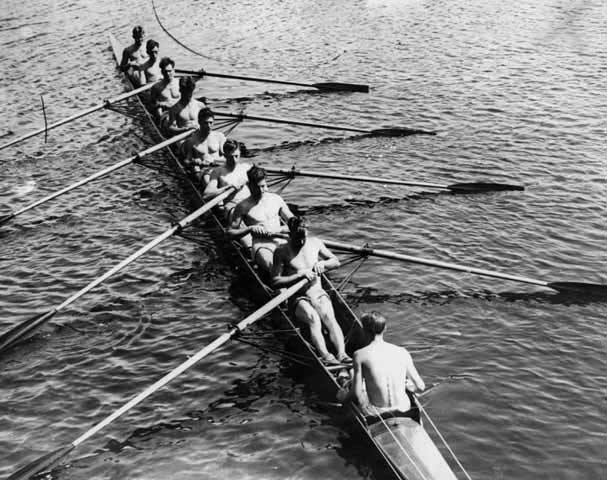
Overhead view of scull crew on the river, 1940. Used with permission of the Minnesota Historical Society.
Brown noted in an interview, “There’s no doubt that something beautiful was lost when the last hand-built cedar shells disappeared from crew races. They were really objects of art as well as utilitarian objects.”
If you haven’t already read The Boys in the Boat, pick it up for summer reading. You’ll gain a beautiful understanding of how rowing fit the era and how the sport shapes the lives of those who row. If you’re ready for more, check out a learn-to-row class to learn the basics of rowing technique and terminology at one of the two local clubs (links below) with roots reaching back to the bungalow era and before.
Resources
The Boys in the Boat: Nine Americans and Their Epic Quest for Gold at the 1936 Berlin Olympics by Daniel James Brown, 2014, Penguin Books.
Minneapolis Rowing Club
tinyurl.com/ya5wvv33
Minnesota Boat Club
tinyurl.com/yaxmxgy2
 Deb McKinley took up rowing in 2015 after years of hearing the voices of coxes and coaches rising from the Mississippi River Gorge as she jogged by. In an “eight,” she typically rows in the bow seat. The rower in this position has enhanced responsibility for the stability and direction of the boat.
Deb McKinley took up rowing in 2015 after years of hearing the voices of coxes and coaches rising from the Mississippi River Gorge as she jogged by. In an “eight,” she typically rows in the bow seat. The rower in this position has enhanced responsibility for the stability and direction of the boat.









